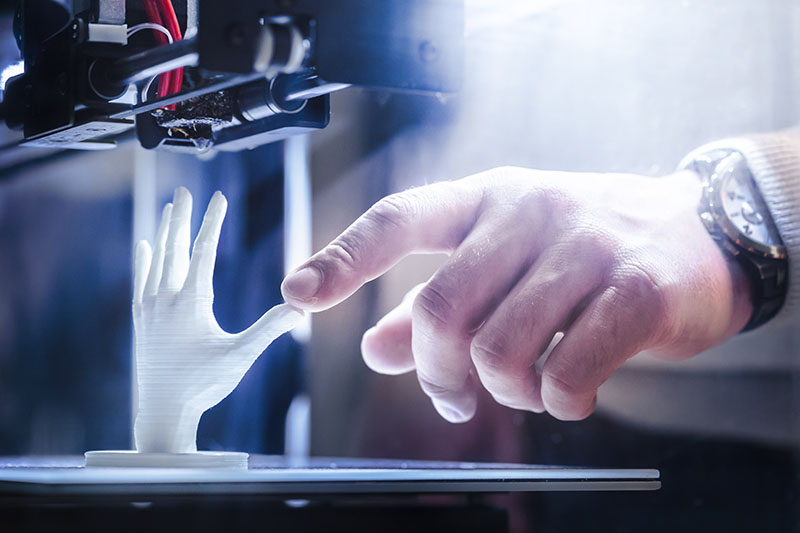3D printing has become a hot topic in recent years, and is being used in a variety of industries such as healthcare, engineering, architecture, and more. However, there is one key tool that 3D printing relies on that could make or break its future: big data.
Without the existence of this advanced data, some of the functions used in 3D printing would not be possible. But how do big data and 3D printing work together? Let’s examine.
What is 3D printing?
3D printing is the process of making a three-dimensional solid object from a digital file. Just like a regular printer prints text or photos created on the computer, a similar process can be done with 3D printing. An individual can design or download an object and then print the object in a full three-dimensional form.
Unlike regular printers, 3D printers work like plotters, moving a point along the X and Y axes. The printed material is typically drawn with plastic rather than ink. Once the object is drawn, the base moves up and down in an ongoing cycle, creating a layered effect until the product is completed in three-dimensional form. Products can be as simple as toys to as complex as medical tools used hospitals. For example, surgeons can replicate patient-specific organs with the help of 3D printers, and they’re even able to produce realistic skin for burn victims or prosthetic limbs for amputees.
What is big data?
While there is an ongoing debate as to what constitutes “big data,” it is essentially a compilation of information that comes from multiple sources. These sources could include satellites, microphones, cameras, computers, and more. The information can be gathered by opt-ins or lead forms, tracking softwares, or cookies. For example, a fitness app may track how many steps an individual takes per day. The sources that allow it to track those steps are all a part of big data.
How do they work together?
3D printing is a data-heavy technology, which means it is essential for both big data and 3D technology to keep up with each other through technological advancements every year. That being said, there are a number of ways in which big data and 3D printing are already proving to be the perfect fit for each other. Two main ways in which they work together are with data visualization and manufacturing.
Data visualization
Visualization tools such as datasets, graphs, charts, or blueprints are used in almost every field in order to better understand aspects like products and company growth. While these tools are extremely useful, with the help of 3D printing, companies can bring their charts or drawings to life. The type of in-depth analysis that 3D printing can create allows for better pattern recognition, deeper information absorption, higher realistic representation of products, and additional product viewpoints. One example of using 3D printing for better data visualization comes from a 2014 case study, where two researchers at MIT, Zachary Weber and Vijay Gadepally, created a 3D printed model of their university campus and added Twitter data which was streamed onto the product based on geographical location. This allowed them to see “twitter volume as a function of time and space to provide insight into campus patterns or life.” Charts and info-graphs can easily show individuals the “numbers” side of a projection, but 3D printing is an even bigger game-changer in the industry as it can offer physical models of such visualizations, which makes the information that much easier to both analyze and understand.
Manufacturing
One key aspect that 3D printing is known for is revolutionizing the modern manufacturing industry, and big data plays a large role in doing so. One way that big data is helping maximize 3D printing’s capabilities is with quality control.
For example, “simple” objects such as children’s blocks may not carry high risk, but when it comes to objects such as car engines or essential parts used in surgeries, the risk factor increases significantly due to safety hazards. In any type of manufacturing, even the smallest of errors can result in fatal accidents or health issues. However, big data can analyze each printing action and internally inspect every element, detecting and correcting any possible imperfection to each product, therefore preventing product risks.
Another example of big data working with 3D printing in the manufacturing aspect is in the case of General Electric’s (GE) 3D printed jet engine fuel nozzle. The nozzle was built as a single piece made up of super alloy dust and then finished with lasers, and is 25% lighter and up to five times more durable than the current nozzle made from 20 different parts. However, since 3D printing is still fairly new to engineers, they have to figure out better quality control methods before they take their products to mass production facilities. With big data, they can do just that. GE Aviation is developing inspection technology that can analyze manufacturing data and identify any issue (such as temperature anomalies) during production using a certain algorithm. Overall, with the use of big data, GE estimates that its inspection technology used for the production of aviation parts could increase production speeds by a quarter and reduce the time allotted for inspection after the product has been made.
Conclusion
The growth of 3D printing is moving fast and could ultimately provide realistic solutions to many different setbacks industry-wide. 3D printing is cost-effective, eco-friendly, and customizable, but when it works together with big data, the combined solution becomes even better as it sparks a new kind of technological revolution.
Related reading:
- 5 Data Analytics Trends for 2020
- How Analytics Helps During an Economic Recession
- Image Recognition: The New Frontier for Targeted Ads



